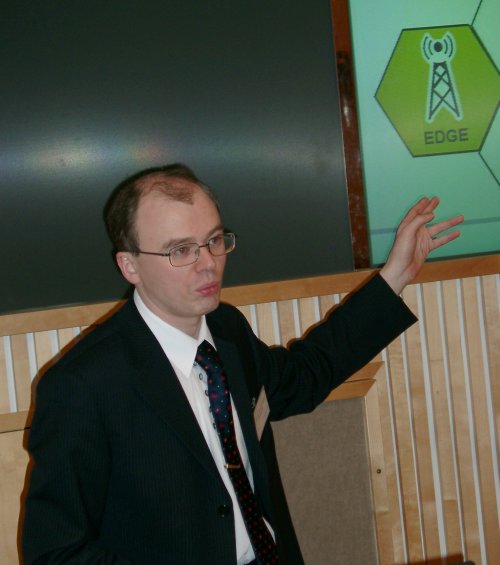
Operators strive to ensure the widest possible range of value-added services, increase ARPU (average revenue per user) and attract more subscribers. It is these reasons and served as the driving force behind the introduction of new technologies on the networks of GSM - GPRS, EDGE, MMS.
The first step towards the introduction of new services was the introduction of packet-switching technology over the air (GPRS.) At the moment of packet data GPRS in place at 350 operators worldwide. Virtually all major cellular operators have implemented the system GPRS - Vodafone, T-Mobile, Orange, Telefonica. It is important to note three things became apparent at the beginning of 2005:
- The number of GPRS subscribers already gained critical mass and is about 10-15%, and in some networks and up to 20%. This indicates that the GPRS system already passed the phase of establishment and won quite popular among subscribers.
- The price of a megabyte of information for the year 2004 substantially reduced. This is explained by the fact that the initial cost of implementing the GPRS has paid off, and the desire to attract new subscribers and make the service mainstream.
- And finally, most importantly: based services GPRS - Internet access, WAP access, e-mail, access corporate networks, telematics, etc., have begun to pay serious money to operators due to massive demand.
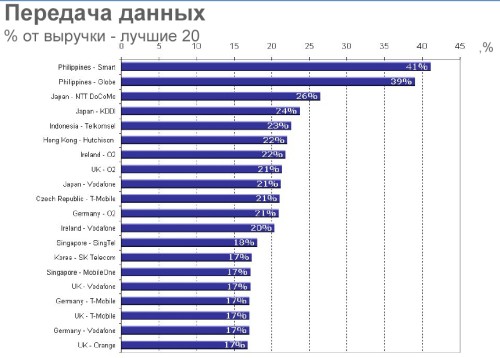
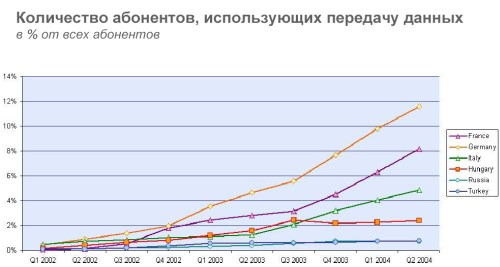
Data transfer rate when working GPRS envy of several components:
- Speed data transmission in one time interval (timeslot) in radiopathes or coding scheme. Four of them: CS1-CS4. The biggest speed is provided when working with CS4 - 21,4 Kbps. On most networks use the first two coding schemes: CS1 and CS2. It should be noted that not all base stations support the encoding scheme CS3-CS4, the old equipment does not have such an opportunity.
- Number of time slots that can be allocated to one subscriber. This option depends on the equipment and our equipment allows us to devote up to 8 timeslots.
- Number of time slots that are currently available for use. This option depends on the network, and it is difficult to predict.
- Number of time slots that can support the phone for downloading information, or phone class. Currently, the most advanced models have a class of 10, or mode 4 +2, ie a maximum of 4 timeslot, to boot.
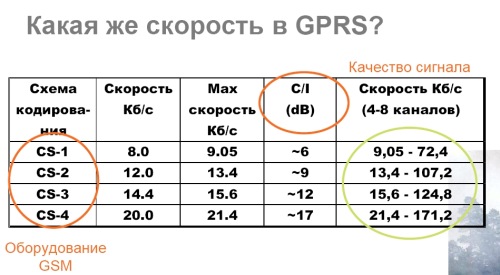
Not all time-slots are equally useful
Here's more detail at this point was particularly interesting. It turns out that the speed of data transmission in GPRS-channel depends not only on the class system, the distance from the BS, weather conditions, moon phases and moods of the girls from subscription services. Much more important parameters of network equipment and its willingness to give data as fast as their phone is able to accept. As it turned out during the discussion, a relatively "mature" base stations are able to work only with the coding schemes CS1 and CS2, which immediately leads to look at the numbers differently. Achieved by Vyacheslav specific "razblyudovki" on the base stations of the Moscow GSM-operators failed, although at some point it seems that sounded something like "pre-emptive CS1/CS2 encoding the two operators." However, the accuracy and reliability of the quotes do not swear, and do it to me could be heard. Play to the political correctness, along with Vyacheslav, amen.Carefully studying the sign at the beginning of the section. The column "Max speed kB / s," we are not very interested, since this is the "Max" probably refers to the total volume of transmitted data, and the excess (the performance) of the information is not going anywhere. Count up speed in ideal conditions (channels more or less free, phone is located near the BS) and consider two typical choices: an old phone in Class 4 (3 +1, ie, 3 slots for receiving and one for transmission) works with the new BS and vice versa: a new phone-class 10 (4 +2) works with the old BS (who were in Moscow, the majority). And what do we see? Speed of transmit / receive data from "old man"-the phone will be 60/20 kb / s, while the apparatus doroguschy latest model - 48/24 kb / s, respectively. And that we have with that network can theoretically give the phone all eight slots, if the phone is able to "digest" Only four? Another conclusion arises for the majority of Moscow's BS: Even in ideal conditions near the BS, an unloaded network, and modern tube speed data acquisition will be about 50 kb / s, which corresponds to the parameters of quality dialup connection. In reality, the parameters of GPRS-connection will be much worse, as well aware of all the many users of mobile Internet networks in Moscow "with the experience."
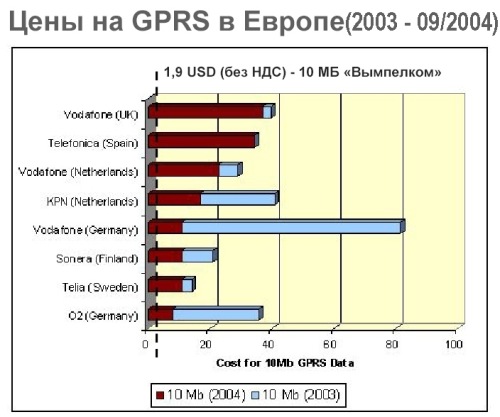
That inhibits GPRS
First is the lack of highly profitable business case in terms of services based on GPRS and as a consequence, the ratio of the GPRS as a secondary service in comparison with the voice. It is therefore not allocated enough funds for it to do data transfer via GPRS is really reliable, high-speed, available at any time for customers without interruption and overload. In addition, operators in Russia face the challenge of attracting subscribers in the network by offering them more favorable tariffs, which not only leads to a redistribution of subscriber base, but also contributes to an increase in voice traffic, which increases the load on the network. Thus, the strong growth of voice traffic is practically nullifying the efforts to optimize GPRS.Decipher:
- GPRS operators in our secondary, including because of low prices of a megabyte. We look at the schedule at the beginning of the section with examples of prices (in dollars per 10 Mb of traffic), and understand that in comparison with their foreign counterparts Russian operators distribute the traffic is almost nothing. The fact that at higher prices this traffic, we would have bought a few irrelevant.
- Regular marketing initiatives to attract new subscribers generate bursts of voice traffic, in these conditions to optimize the data network does not work and rely on the stable operation of GPRS is not necessary.
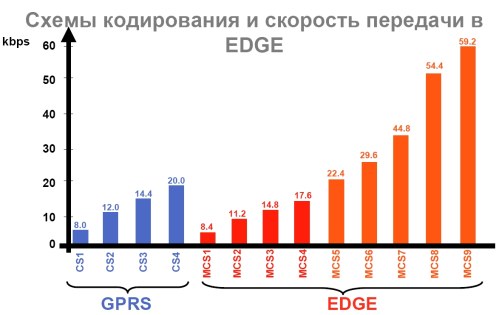
EDGE: brighter prospects?
EDGE (Enhanced Data for Global Evolution) is an advanced technology that provides high-speed transfer of large amounts of information in the mobile network. EDGE technology supports data transfer rates, on average, three times the possibility of GPRS, in addition, provides more efficient use of frequency resources and improve network coverage compared to the conventional network standard, GSM. Maximum achievable data transfer rate - 474.6 Kbps. Thus, the EDGE technology offers mobile operator able to provide its customers data services in existing GSM frequency spectrum with speeds characteristic of third generation mobile communication (3G).EDGE technology was originally invented by Ericsson for network standard D-AMPS in the late 90's. Assessing the potential of new items, Ericsson moved this innovation in the network GSM.
But it is necessary to take into account one important factor - the introduction of EDGE - it's introducing a new modulation of the radio channel between base station and mobile terminal. For the introduction of EDGE in cellular network operator requires EDGE-compatible transmitters in the base stations and, accordingly, phones that support EDGE.
Peak construction of GSM networks in Europe has fallen to the middle and late 90's, when base stations have not yet had the EDGE-functionality. With increasing capacity of networks of integrated into a network of more new transceivers, including the EDGE-compatible, but despite this, their share is small. In Russia the situation is somewhat different. Delay the introduction of networks GSM, the absence of major federal operators at the initial stage and the crisis of 1998 led to the boom of the development of GSM-networks began only last year and is now actively going on. Russian operators originally purchased for many networks, EDGE-compatible equipment. Thus, the European question, "To build or not build the EDGE network?" transformed into the Russian - "Run or not run EDGE network?". Especially, the feasibility of EDGE networks in the Russian operators seem more logical, as the implementation dates WCDMA networks in Russia is not yet defined. For the introduction of EDGE will need to do and many other important steps - to finalize the radio planning, optimize the transmission and IP-networks segment - but the first step - the introduction of EDGE transmitters in the network - largely completed.
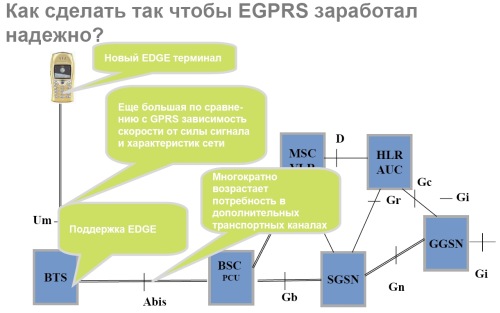
- Administrative matters. In the EDGE system used is different from the GPRS signal modulation, which involves obtaining a permit. We understand that the Ministry of Communications as a result of simply "keep quiet", ignoring questions. The position of regulators easy to understand: officially authorize without understanding - you do not want, something might not work out, grasp the features of the technology and give meaningful requirements / recommendations - so it is necessary to understand! So it was or not is known only to the bureaucrats themselves, semi-legal or quasi-EDGE still running and the like (yet?) None of it was not shot and did not even planted. However, some caution is still visible.
- Indeed, for a number of years, the main producers supply only the EDGE-compatible equipment. In this sense, almost certainly fortunate regions, where the new GSM networks were built relatively recently. However, the largest network of much older, their total upgrade will cost more.
- In addition to the EDGE-compatible network equipment required to transport dramatically increased data traffic between base stations and other network nodes. Relatively "low-speed" GPRS is already loading the transport network two times more than using the same radio resources voice traffic, and what will happen to the EDGE? At six to seven times? Most mobile network bandwidth transport will increase, without the launch of EDGE in all territorial network fragment loses its meaning.
- Price of inclusion - that manufacturers do not advertise. EDGE support built into the equipment at the hardware level, but to include this functionality and start to use it only for a very extra money.Given the low retail prices for GPRS traffic to Russian operators have to think about.
Another frequently asked question - the principles of charging EDGE-traffic. Technically, the separate billing of GPRS and EDGE (EGPRS) is not provided, ie take from the subscriber any additional money specifically for the use of EDGE operator can not be in any way.
UMTS - the next step
The question arises: if the speed of EDGE, even more than in the UMTS (474,6 kb / s versus 384 kb / s), then why build the next generation network?Let us dwell on this aspect, as the speed of data transmission. If the maximum data transfer speed with EDGE is 474.6 kb / s, in UMTS 384 kb / s - is the minimum speed. Now it has become a reality the first step in the development of UMTS - WCDMA Evolved. The term WCDMA Evolved ("Advanced WCDMA") reflects a natural further development of the standard WCDMA, whose use and benefit to end users and operators. Standard Ericsson WCDMA Evolved, which was applied technology high-speed packet access downlink High Speed Downlink Packet Access (HSDPA) is a fully standardized solution for WCDMA. The first stage of development will be a significant increase in available peak data rate on the downlink and 14 Mbps and an increase of more than twice the system bandwidth for data transmission within the current radio spectrum.
It should be noted that the approach to 3G networks only in terms of speed - a simplified approach. UMTS networks are tailored to meet the most modern security services. Initially, the technological capabilities of 3G networks is the possibility of simultaneous voice and data, there are mechanisms to ensure quality services and more. And if the new data transfer technology GPRS / EDGE for GSM in something "alien" in relation to the network (and hence the problem), the UMTS network free of these shortcomings. Yes, for the transitional phase, EDGE is quite suitable, but make him a bet in the long term appears to be erroneous.
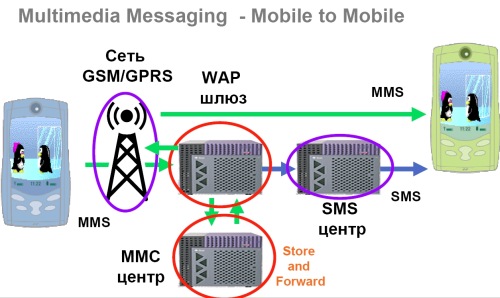
MMS: On some non-obvious features of the technology
Many different questions on the subject would be discussed. Unfortunately, the meeting is not possible to "grasp the immensity, it is hoped to continue in the future. A few words about the suffering of multimedia messages MMS, which despite rosy predictions so hard and squeaked gaining popularity.The main problems with the implementation of services:
- Non-guaranteed delivery time of MMS.
- MMS loss during delivery.
- Incorrect display of the phone sent content.
- Time Frame MMS
- Overloading of equipment, reuse of WAP gateways for access to sites and to work with MMS
- The problems of the transport layer - GSM / GPRS
- Deficiencies in the certification of MMS technology and nonconformity of the delivered equipment MMS standards.
Such complexity in implementation due to deliver including security considerations. Initialization Interface GPRS-session directly from a network exists, but currently is not used deliberately. Ie GPRS-session can be initialized by the user, or at least, a special team of SMS-Centre. Incidentally, all this is true for the new service push-to-talk: in the recipient's telephone voice message first goes SMS-command to launch GPRS-session and then the machine receives a voice message via GPRS. This and a half to two second pause between pressing the button and the audio signal is possible nagovarivaniya and send a message.